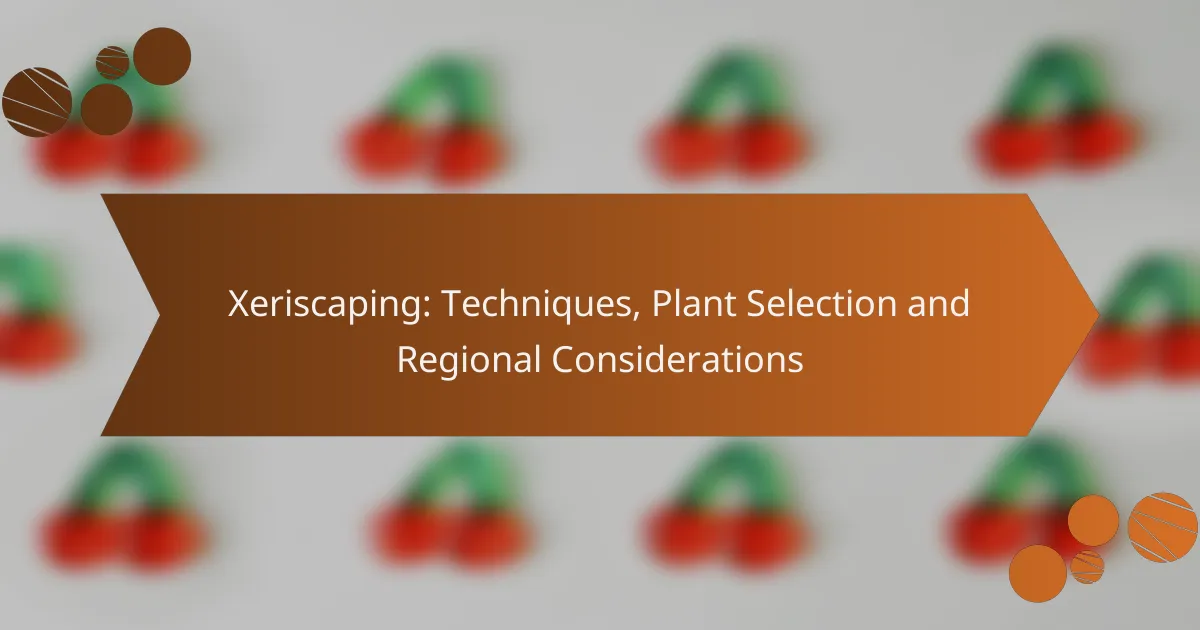Xeriscaping is an innovative landscaping approach designed to conserve water and enhance sustainability, particularly in arid regions like Phoenix and Tucson. By employing techniques such as soil amendment, mulching, and drip irrigation, homeowners can create beautiful, low-maintenance landscapes that thrive in dry climates. Selecting native and drought-tolerant plants not only reduces water usage but also supports local biodiversity, making xeriscaping a practical and environmentally friendly choice.
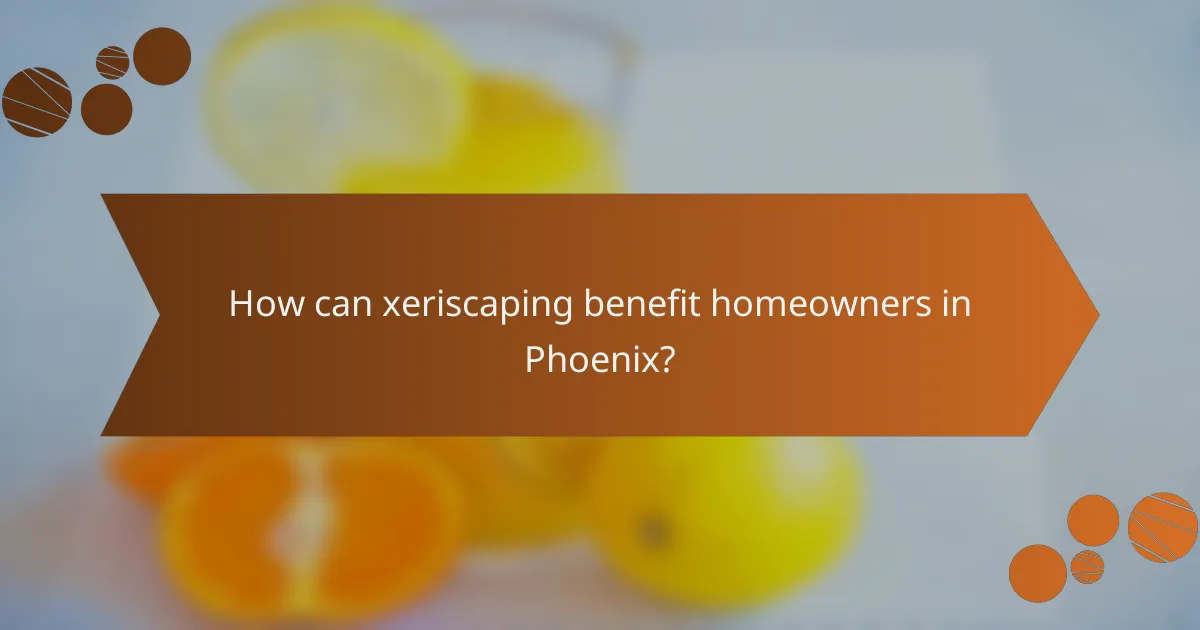
How can xeriscaping benefit homeowners in Phoenix?
Xeriscaping can significantly benefit homeowners in Phoenix by reducing water usage, lowering maintenance costs, and enhancing property value. This landscaping approach is particularly suited for arid climates, making it ideal for the desert environment of Phoenix.
Water conservation
Xeriscaping focuses on using drought-resistant plants and efficient irrigation techniques, which can lead to substantial water savings. Homeowners can reduce their outdoor water consumption by up to 50% compared to traditional landscaping methods. This is especially crucial in Phoenix, where water resources are limited and conservation is essential.
Implementing drip irrigation systems and mulching can further enhance water efficiency. These methods minimize evaporation and ensure that plants receive the moisture they need without excessive waste.
Lower maintenance costs
By selecting low-maintenance plants and designing landscapes that require less upkeep, xeriscaping can lower overall maintenance costs for homeowners. Native and drought-tolerant plants typically need less frequent watering, pruning, and fertilization, which translates to reduced labor and material expenses.
Additionally, xeriscaped gardens often require fewer pest control measures, as native plants are more resilient to local pests. This can lead to further savings on chemical treatments and professional services.
Enhanced property value
Xeriscaping can increase property value by creating visually appealing landscapes that are both sustainable and environmentally friendly. Homes with well-designed xeriscaped yards often attract buyers looking for energy-efficient and low-maintenance properties.
Moreover, as water conservation becomes a priority in urban planning, properties with xeriscaping may be viewed more favorably in the market. This trend can lead to higher resale values, making xeriscaping a wise investment for homeowners in Phoenix.
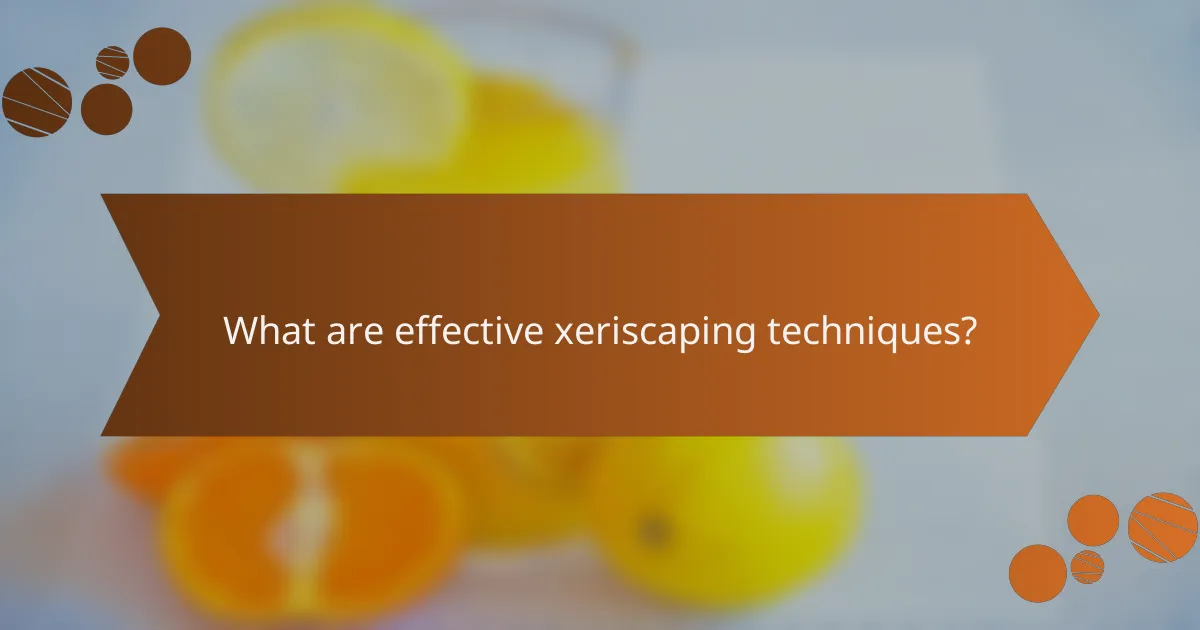
What are effective xeriscaping techniques?
Effective xeriscaping techniques focus on water conservation while creating a sustainable landscape. These methods include soil amendment, mulching, and drip irrigation, each contributing to a more efficient use of water resources.
Soil amendment
Soil amendment involves improving the soil’s structure and nutrient content to enhance water retention. Adding organic materials like compost or well-rotted manure can significantly increase the soil’s ability to hold moisture, which is crucial in xeriscaping.
When amending soil, aim for a mix that retains water without becoming overly compacted. A good rule of thumb is to incorporate about 25-30% organic matter into the existing soil. Testing the soil pH can also help determine the right amendments needed for optimal plant growth.
Mulching
Mulching is a technique that involves covering the soil surface with materials like wood chips, straw, or gravel to reduce evaporation and suppress weeds. A layer of mulch, typically 2-4 inches thick, can significantly lower soil temperature and maintain moisture levels.
Choose organic mulches for added nutrients as they decompose, or opt for inorganic options for longer-lasting coverage. Regularly check and replenish mulch as needed to maintain its effectiveness throughout the growing season.
Drip irrigation
Drip irrigation is a highly efficient watering method that delivers water directly to the plant roots, minimizing waste. This system uses a network of tubing and emitters to provide a slow, steady supply of moisture, making it ideal for xeriscaping.
When installing a drip irrigation system, consider the layout of your garden and the specific water needs of different plants. Timers can help automate watering schedules, ensuring that plants receive consistent moisture without overwatering. Regular maintenance is essential to prevent clogs and ensure optimal performance.
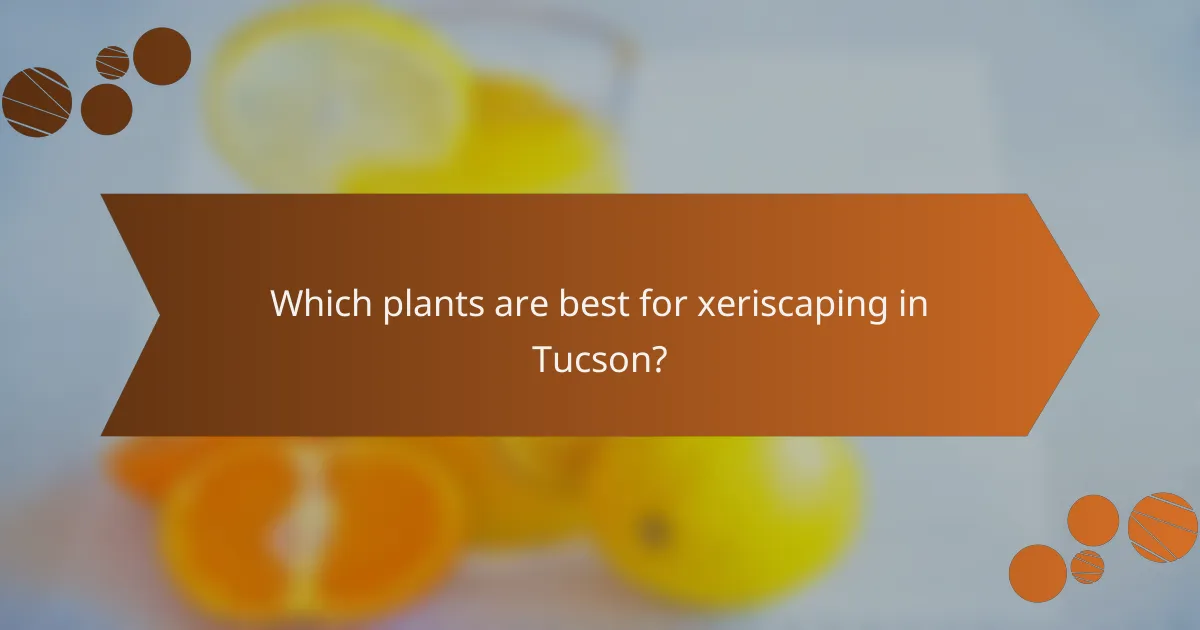
Which plants are best for xeriscaping in Tucson?
In Tucson, the best plants for xeriscaping are those that thrive in arid conditions and require minimal water. Selecting native and drought-tolerant species helps create a sustainable landscape that conserves water while enhancing local biodiversity.
Native desert plants
Native desert plants are well-adapted to Tucson’s climate and soil, making them ideal for xeriscaping. Species such as the saguaro cactus, ocotillo, and desert marigold not only survive with little water but also provide habitat for local wildlife.
When choosing native plants, consider their growth habits and seasonal changes. Many native plants bloom at different times of the year, adding color and interest to your landscape throughout the seasons.
Drought-tolerant succulents
Drought-tolerant succulents are another excellent choice for xeriscaping in Tucson. Varieties like agave, aloe vera, and sedum store water in their leaves, allowing them to thrive in dry conditions. These plants often require minimal maintenance and can be used as focal points in garden designs.
When incorporating succulents, ensure they are planted in well-draining soil to prevent root rot. Grouping different types can create visually appealing arrangements while maximizing water efficiency.
Low-water shrubs
Low-water shrubs are essential for creating a xeriscaped garden that offers structure and privacy. Plants such as desert willow, red yucca, and Texas sage are great options that require little irrigation once established.
Consider the mature size and growth rate of these shrubs when planning your landscape. Planting them in clusters can create a natural look while providing shade and reducing evaporation in the surrounding soil.

What regional considerations should be made for xeriscaping?
When planning a xeriscape, it’s essential to consider the specific regional climate, soil types, and local plant species. These factors influence water availability, plant health, and overall landscape sustainability.
Climate adaptation
Climate adaptation involves selecting plants that thrive in your local weather conditions. For instance, in arid regions, choose drought-resistant species that can withstand high temperatures and low rainfall. Conversely, in temperate areas, you may have more flexibility with plant choices, but it’s still crucial to consider seasonal variations.
Understanding your area’s climate zones can help in selecting appropriate plants. The USDA Plant Hardiness Zone Map is a useful tool for determining which plants will survive in your region’s temperature ranges.
Soil type analysis
Soil type analysis is vital for successful xeriscaping, as different plants require specific soil conditions. Conduct a soil test to determine pH, nutrient levels, and drainage capabilities. Sandy soils drain quickly and may require more frequent watering, while clay soils retain moisture but can lead to root rot if not properly managed.
Once you know your soil type, amend it as needed to improve drainage or nutrient content. For example, adding organic matter can enhance sandy soils, while incorporating gypsum can help improve clay soil structure.

How to design a xeriscape garden layout?
Designing a xeriscape garden layout involves creating an efficient plan that minimizes water use while maximizing aesthetic appeal. Focus on grouping plants with similar water needs and incorporating hardscapes to reduce irrigation requirements.
Zone planting
Zone planting is a technique that involves grouping plants based on their water and sunlight needs. By placing drought-tolerant plants together, you can optimize irrigation and reduce waste. For example, place succulents and cacti in sunny areas while locating shade-loving plants in cooler spots.
Consider the microclimates in your garden, such as areas that receive more wind or shade. This allows you to select plants that will thrive in each specific zone, enhancing the overall health and sustainability of your xeriscape.
Pathway placement
Pathway placement is crucial in a xeriscape garden as it influences both accessibility and water drainage. Design paths to guide visitors through the garden while ensuring they do not disrupt plant zones. Use materials like gravel or decomposed granite that allow water to permeate and reach plant roots.
When planning pathways, consider their width and layout. A width of around 60-90 cm is often sufficient for foot traffic. Additionally, ensure pathways are positioned to minimize erosion and runoff, which can help maintain soil moisture for your xeriscape plants.
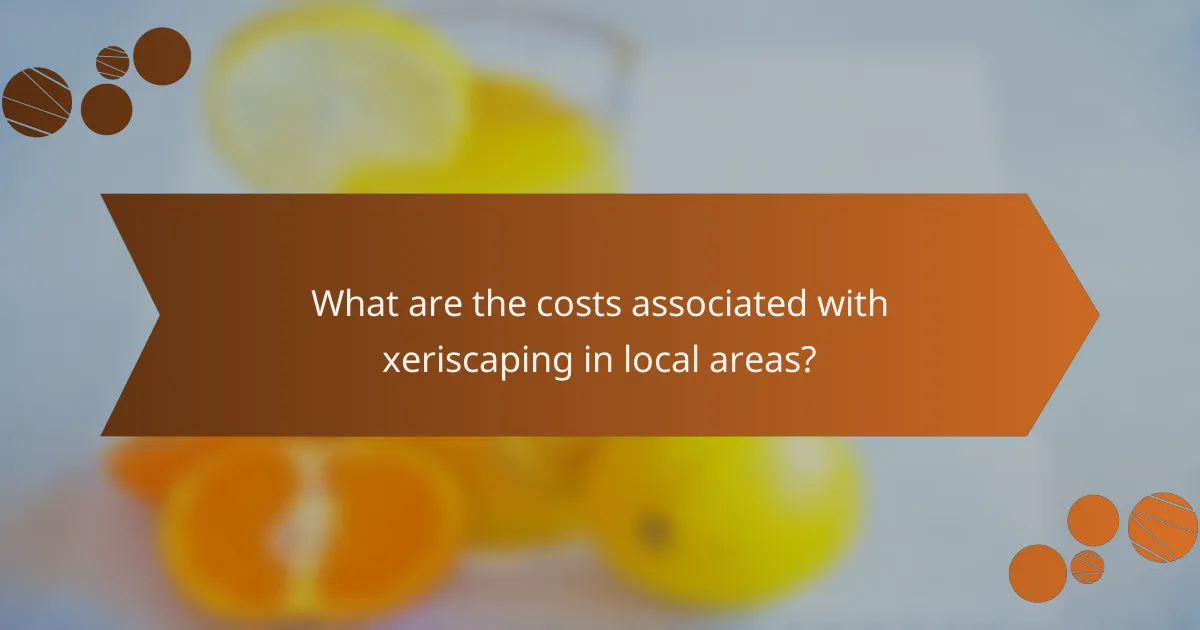
What are the costs associated with xeriscaping in local areas?
The costs associated with xeriscaping can vary significantly based on local conditions, plant selection, and installation methods. Generally, initial expenses may be higher than traditional landscaping, but long-term savings on water bills and maintenance can offset these costs.
Initial installation costs
Initial installation costs for xeriscaping typically range from moderate to high, depending on the complexity of the design and the types of plants chosen. Homeowners can expect to spend anywhere from a few hundred to several thousand dollars. Factors influencing these costs include soil preparation, irrigation systems, and the selection of drought-resistant plants.
For example, installing a simple xeriscape garden in a small yard may cost around 500-1,500 USD, while larger projects with intricate designs and high-quality materials can exceed 5,000 USD. It’s advisable to obtain multiple quotes from local landscapers to find the best price and service.
Long-term savings
Long-term savings from xeriscaping primarily come from reduced water usage and lower maintenance costs. Homeowners can save up to 50% or more on their water bills, especially in arid regions where water is scarce and expensive. Additionally, xeriscaped gardens typically require less frequent mowing, fertilizing, and pest control, further reducing ongoing expenses.
Over time, these savings can add up significantly. For instance, if a household spends around 600 USD annually on water for a traditional garden, switching to xeriscaping could lead to savings of 300 USD or more each year. This makes xeriscaping not only an environmentally friendly choice but also a financially savvy one in the long run.
